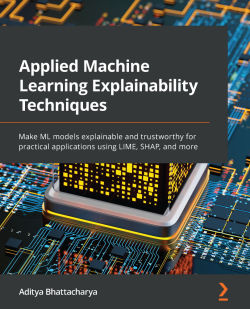3 Days, 20+ AI Experts, 25+ Workshops and Power Talks
Code: USD75OFF
This is the code repository for Applied Machine Learning Explainability Techniques, published by Packt.
Make ML models explainable and trustworthy for practical applications using LIME, SHAP, and more
Explainable AI (XAI) is an emerging field that brings artificial intelligence (AI) closer to non-technical end users. XAI makes machine learning (ML) models transparent and trustworthy along with promoting AI adoption for industrial and research use cases.
This book covers the following exciting features:
- Explore various explanation methods and their evaluation criteria
- Learn model explanation methods for structured and unstructured data
- Apply data-centric XAI for practical problem-solving
- Hands-on exposure to LIME, SHAP, TCAV, DALEX, ALIBI, DiCE, and others
- Discover industrial best practices for explainable ML systems
- Use user-centric XAI to bring AI closer to non-technical end users
- Address open challenges in XAI using the recommended guidelines
If you feel this book is for you, get your copy today!
All of the code is organized into folders.
The code will look like the following:
X = series.values
X = X.astype('float32')
size = len(X) - 1
train, test = X[0:size], X[size:]
# fit an ARIMA model
model = ARIMA(train, order=(2,1,1)) # Simple ARIMA time series forecast model
model_fit = model.fit()
# forecast
forecast = model_fit.predict(start=366, end=466)
for i in range(len(forecast)):
forecast[i] = random.random() * 10 + forecast[i]
result = model_fit.get_forecast()
con_interval = result.conf_int(0.05))
Following is what you need for this book: This book is designed for scientists, researchers, engineers, architects, and managers who are actively engaged in the field of Machine Learning and related areas. In general, anyone who is interested in problem-solving using AI would be benefited from this book. The readers are recommended to have a foundational knowledge of Python, Machine Learning, Deep Learning, and Data Science. This book is ideal for readers who are working in the following roles: • Data and AI Scientists • AI/ML Engineers • AI/ML Product Managers • AI Product Owners • AI/ML Researchers • User experience and HCI Researchers
With the following software and hardware list you can run all code files present in the book (Chapter 1-11).
You can install the software required in any operating system by first installing Jupyter Notebook or Jupyter Lab with the most recent version of Python, or install Anaconda which can install everything at once. While hardware requirements for Jupyter are relatively modest, we recommend a machine with at least 4 cores of 2Ghz and 8Gb of RAM.
Alternatively, to installing the software locally, you can run the code in the cloud using Google Colab or another cloud notebook service.
Either way, the following packages are required to run the code in all the chapters (Google Colab has all the packages denoted with a ^):
| Chapter | Software required | OS required |
|---|---|---|
| 2 - 9 | ^ Python 3.6+ | Windows, Mac OS X, and Linux (Any) |
| 2 - 9 | ^ matplotlib 3.2.2+ | Windows, Mac OS X, and Linux (Any) |
| 2 - 9 | ^ scikit-learn 0.22.2+ | Windows, Mac OS X, and Linux (Any) |
| 2 - 9 | ^ pandas 1.1.5+ | Windows, Mac OS X, and Linux (Any) |
| 2 - 9 | ^ numpy 1.19.5+ | Windows, Mac OS X, and Linux (Any) |
| 2 - 9 | ^ seaborn 0.11.1+ | Windows, Mac OS X, and Linux (Any) |
Alternatively, you can install libraries one chapter at a time inside of a local Jupyter environment using cells with !pip install or run all the code in Google Colab. The following are the list of the code tutorials provided for the corresponding chapters for this book:
- Chapter 02 - Model Explainability Methods
- Chapter 03 - Data Centric Approaches
- Chapter 04 - Introduction to LIME for Model Interpretability
- Chapter 05 - Practical Exposure of Using LIME in ML
- Chapter 06 - Model Interpretability Using SHAP
- Chapter 07 - Practical Exposure of Using SHAP in ML
- Chapter 08 - Human-friendly Explanations with TCAV
- Chapter 09 - Other Popular XAI Frameworks-
Remember to make sure you click on the menu item "File > Save a copy in Drive" as soon you open each link to ensure that your notebook is saved as you run it. Also, notebooks denoted with plus sign (+) are relatively compute-intensive, and will take an extremely long time to run on Google Colab but if you must go to "Runtime > Change runtime type" and select "High-RAM" for runtime shape. Otherwise, a better cloud enviornment or local environment is preferable.
We also provide a PDF file that has color images of the screenshots/diagrams used in this book. Click here to download it.
Aditya Bhattacharya is an Explainable AI Researcher at KU Leuven with an overall experience of 7 years in Data Science, Machine Learning, IoT & Software Engineering. Prior to his current role, Aditya has worked in various roles in organizations like West Pharma, Microsoft & Intel to democratize AI adoption for industrial solutions. As the AI Lead at West Pharma, he had contributed to forming the AI Centre of Excellence, managing & leading a global team of 10+ members focused on building AI products. He also holds a Masters’s degree from Georgia Tech in Computer Science with ML and a Bachelor’s degree from VIT University in ECE. Aditya is passionate about bringing AI closer to end-users through his various initiatives for the AI community.
If you have already purchased a print or Kindle version of this book, you can get a DRM-free PDF version at no cost.
Simply click on the link to claim your free PDF.


